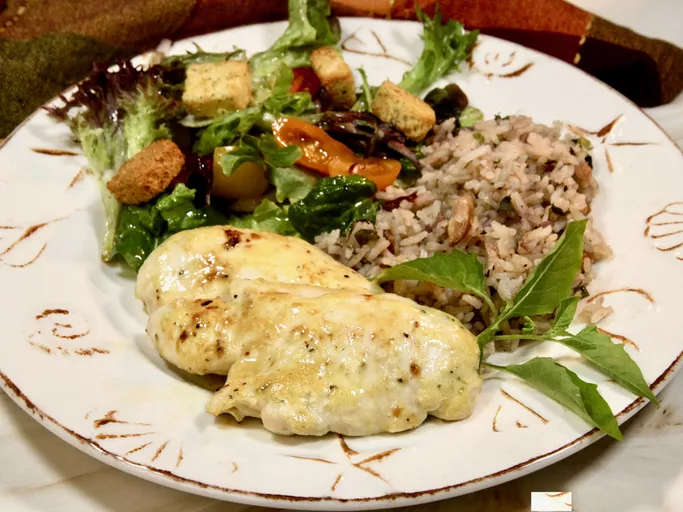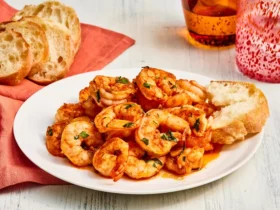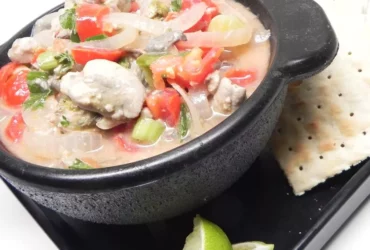Ingredients
For the marinade
To make the marinade for the Dijonnaise chicken recipe, you will need a combination of ingredients that blend together to create a flavorful and aromatic mixture. Here are the key components:
The base of the marinade is made up of olive oil and white wine vinegar, which provide a tangy and slightly sweet flavor profile. The ratio of olive oil to white wine vinegar should be approximately 3:1, with 3 parts olive oil to 1 part white wine vinegar.
Next, you will need to add some Dijon mustard to the marinade. This type of mustard is made from brown and white mustard seeds, which have been ground into a smooth paste. The addition of Dijon mustard adds a tangy, slightly spicy flavor to the marinade.
The other key ingredient in the marinade is chopped fresh herbs, such as parsley or thyme. These herbs add a bright, refreshing flavor to the dish and help to balance out the richness of the chicken. You can use either one type of herb or a combination of both, depending on your personal preference.
Finally, you will need to add some garlic and black pepper to the marinade. The garlic adds a pungent, savory flavor, while the black pepper adds a sharp, slightly sweet note. Be careful not to overdo it with the garlic, as it can quickly become overpowering.

The following is the list of ingredients needed for the marinade:
- 2/3 cup olive oil
- 1/4 cup white wine vinegar
- 2 tablespoons Dijon mustard
- 2 cloves garlic, minced
- 1 teaspoon dried thyme
- 1 teaspoon dried parsley
- 1/2 teaspoon black pepper
Remember to adjust the amount of each ingredient according to your personal taste preferences and the size of your chicken pieces. The marinade should be applied liberally, but not excessively, to ensure that the flavors penetrate evenly throughout the meat.
1/2 cup Dijonnaise sauce
Dijonnaise sauce is a key ingredient in many recipes, including the popular Dijonnaise Chicken Recipe. It is a condiment made from a combination of mayonnaise and Dijon mustard.
The mayonnaise provides a rich and creamy texture to the sauce, while the Dijon mustard adds a tangy and slightly sweet flavor. The two ingredients are typically mixed together in equal proportions, although some recipes may call for more mayonnaise or more mustard depending on personal taste preferences.
In terms of ingredients, standard mayonnaise is usually made from a combination of oil (such as canola or soybean oil), egg yolks, vinegar or lemon juice, salt, and water. Dijon mustard, on the other hand, is typically made from brown or black mustard seeds, white wine, salt, and spices.
The specific ingredients used to make Dijonnaise sauce may vary depending on the recipe or brand being used. However, most commercial brands of Dijonnaise sauce are made from a combination of mayonnaise, Dijon mustard, water, vinegar or lemon juice, sugar or salt, and spices.
Some common ingredients found in homemade Dijonnaise sauce include chopped fresh herbs such as parsley, dill, or chives; grated onion or garlic for added flavor; and a pinch of paprika or other spices to add depth and warmth to the sauce. These extra ingredients can help to enhance the flavor and texture of the final dish.
When using Dijonnaise sauce in a recipe like the Dijonnaise Chicken Recipe, it is typically spread on top of cooked chicken breasts or thighs before baking or grilling. The sauce adds moisture and flavor to the chicken, while also creating a crispy golden-brown crust when cooked under the broiler.
Overall, Dijonnaise sauce is a versatile condiment that can be used in a variety of recipes beyond just the Dijonnaise Chicken Recipe. Its creamy texture and tangy flavor make it a great addition to sandwiches, salads, dips, and other dishes.
1 tablespoon olive oil
The first ingredient in the Dijonnaise Chicken Recipe is olive oil, which plays a crucial role in cooking the chicken. Here are some key facts about this ingredient:
- Olive oil is extracted from olives and is often used as a finishing oil due to its distinct flavor and aroma.
- One tablespoon of olive oil contains approximately 120 calories, which contribute to the overall energy content of the dish.
- Olive oil adds moisture and tenderness to the chicken, making it more palatable and easier to digest.
- The fatty acids present in olive oil have antioxidant properties that help protect against cell damage and inflammation.
When used in cooking, olive oil can impart a rich, slightly nutty flavor to dishes. It’s an excellent choice for high-heat cooking, such as sautéing or searing, due to its relatively high smoke point.
In the context of the Dijonnaise Chicken Recipe, the olive oil is used to coat the chicken breasts before seasoning and baking. This helps create a crispy exterior while maintaining the tender interior of the meat.
1 teaspoon lemon zest
The Dijonnaise Chicken Recipe is a delightful and flavorful dish that combines the richness of chicken with the tanginess of Dijon mustard, all perfectly balanced by the brightness of lemon zest. To bring this recipe to life, you will need the following ingredients:
- 1 pound boneless, skinless chicken breasts
- 2 tablespoons olive oil
- 2 cloves garlic, minced
- 1 teaspoon Dijon mustard
- 1/2 cup white wine (optional)
- 1 tablespoon chopped fresh parsley
- 1 teaspoon lemon zest (this is where the magic happens!)
- Salt and pepper to taste
- 1/4 cup grated Gruyère cheese (optional, but oh so delightful)
The star of the show is undoubtedly the lemon zest. One teaspoon may seem like a small amount, but trust us when we say that it makes all the difference in this dish.
Lemon zest is the outer layer of the lemon peel, which contains tiny oil glands that give lemons their characteristic flavor and aroma. When you grate or zester the lemon peel, you release these oils and flavors into your dish, adding a brightness and depth that complements the richness of the chicken and the earthiness of the Dijon mustard.
When using lemon zest in this recipe, be sure to use high-quality lemons with thick, easily grate-able skin. The most common varieties for cooking are Eureka or Meyer lemons, but feel free to experiment with other types you have on hand.
To incorporate the lemon zest into your Dijonnaise Chicken Recipe, simply grate it over the chicken before serving, or mix it in with the sauce during the last few minutes of cooking. Either way, you’ll be rewarded with a dish that’s sure to impress!
1 minced garlic clove
A single minced garlic clove is an essential ingredient in the Dijonnaise chicken recipe, which adds a rich and savory flavor to the dish.
The garlic clove is typically minced or finely chopped before being added to other ingredients, allowing its aromatic oils to be released and blend with the flavors of the other components.
In the context of this particular recipe, the minced garlic clove is combined with Dijonnaise sauce, mayonnaise, chopped fresh herbs like parsley or chives, and a pinch of salt and pepper to create a creamy and tangy dressing for the chicken.
The use of a single garlic clove also ensures that the flavor of the dish doesn’t become overpowering, allowing the natural taste of the chicken to shine through while still adding depth and complexity to the overall flavor profile.
Furthermore, the minced garlic clove is often mixed with the Dijonnaise sauce before it’s brushed onto the chicken during cooking, allowing the flavors to meld together and create a smooth, even coating on the surface of the meat.
Overall, the minced garlic clove plays a crucial role in the Dijonnaise chicken recipe, adding a subtle yet essential layer of flavor that enhances the overall taste experience.
Salt and pepper to taste
The Dijonnaise Chicken Recipe relies heavily on a variety of ingredients to create its unique flavor profile.
Essential Ingredients
The following are the fundamental components necessary for this recipe:
- Dijon mustard – This ingredient serves as the foundation for the dish’s name and contributes a tangy, slightly spicy flavor.
- Mayonnaise – Adding richness and creaminess to the sauce, mayonnaise complements the Dijon mustard well.
- Butter – Unsalted butter is used in the recipe to enhance the flavors of the other ingredients without adding saltiness.
- Chicken breasts – Boneless, skinless chicken breasts form the base of the dish and are typically cooked via pan-frying or grilling.
Accompanying Ingredients
The following items enhance the overall taste experience but aren’t essential:
- Celery – Chopped celery adds a fresh, slightly bitter flavor and helps balance out the richness of the other ingredients.
- Chives or parsley – These herbs are often used as garnishes to add a pop of color and freshness to the dish.
Savory Enhancers
The following ingredients contribute to the savory flavor profile:
- Cream cheese – Softened cream cheese is blended with the Dijon mustard, mayonnaise, and butter to create a smooth sauce.
- Black pepper – Like salt, black pepper enhances flavors but should be used judiciously.
Taste Adjustments
The final seasoning component is often adjusted according to personal taste:
- Salt and pepper to taste
Instructions
Mix the marinade ingredients in a bowl
To create the marinade for the Dijonnaise chicken recipe, start by gathering all the necessary ingredients in a bowl.
The ingredients include:
- 2 cloves of garlic, minced
- 1 tablespoon of Dijon mustard
- 1 teaspoon of dried thyme
- 1/2 teaspoon of paprika
- 1/2 teaspoon of salt
- 1/4 teaspoon of black pepper
- 2 tablespoons of olive oil
- 2 tablespoons of white wine vinegar or apple cider vinegar
Mix the ingredients together until they are well combined. Be sure to scrape down the sides of the bowl with a spatula as needed to ensure everything is fully incorporated.
Once the marinade is prepared, you can proceed to coat the chicken in it. For best results, marinate the chicken for at least 30 minutes to an hour before cooking.
Remember to adjust the amount of garlic and other seasonings to taste. You can also add or substitute ingredients based on your personal preferences.
Whisk together Dijonnaise sauce, olive oil, lemon zest, garlic, salt, and pepper.
To prepare the Dijonnaise sauce, gather all the required ingredients which include Dijon mustard, mayonnaise, olive oil, lemon zest, garlic, salt, and pepper.
Next, in a medium-sized bowl or container that is suitable for whisking, combine the Dijonnaisse sauce with the remaining ingredients – olive oil, lemon zest, garlic, salt, and pepper. The purpose of combining these ingredients in this manner is to ensure that they are properly mixed and distributed evenly throughout the sauce.
The use of a bowl is essential as it allows for easy mixing and prevents any ingredients from spilling or getting wasted during the process. When whisking together the ingredients, make sure to cover all surfaces thoroughly to avoid leaving behind any lumps or uneven textures in the sauce.
Start by gently placing the whisk into the mixture and begin moving it in a smooth, continuous motion, making sure to scrape the sides of the bowl occasionally as you go. This action will help break down any stubborn ingredients that may be resisting mixing and ensure an even consistency throughout the Dijonnaise sauce.
Continue to whisk until all the ingredients have been well incorporated, and the mixture has reached your desired consistency. You can adjust this according to your preference for either a smooth or slightly thicker texture.
Once you are satisfied that the Dijonnaise sauce is ready, set it aside for use in preparing the Dijonnaisse Chicken Recipe. The sauce will be a fundamental component of the dish, adding a rich and creamy flavor to the chicken while also providing a nice contrast to its crunchy exterior.
Now that you have prepared the Dijonnaise sauce, let’s proceed with the main course: the preparation of the chicken. In this step, we will season the chicken with salt, pepper, and other spices before dipping it in the Dijonnaisse sauce to coat evenly.
According to the USDA, when handling raw poultry, always make sure your hands are clean and sanitized to prevent cross contamination.
When it comes to following instructions, especially in a recipe like the Dijonnaise Chicken Recipe, attention to detail and adherence to guidelines are crucial to ensure a successful outcome.
The given instruction from the USDA on handling raw poultry highlights the importance of maintaining cleanliness and sanitizing hands when handling this type of food item. Raw poultry, being high-risk for contamination due to its natural bacteria load, can easily cause foodborne illnesses if not handled correctly.
This emphasis on hand hygiene is not unique to poultry or even cooking. In many professional settings, especially in healthcare or food service industries, maintaining a clean and sanitized environment is paramount to preventing the spread of pathogens.
The principle behind this instruction is based on the concept of cross-contamination, where harmful bacteria are transferred from one surface or object to another without adequate cleaning or sanitizing procedures. This can lead to the growth of dangerous microorganisms that can cause illness.
Applying this principle in everyday cooking scenarios means that home cooks should make sure their hands are clean and sanitized before and after handling raw poultry, as well as when preparing other food items that might have come into contact with these potentially contaminated surfaces.
Making a habit of sanitizing your hands, especially after touching raw poultry or any other high-risk foods, is not just about following instructions; it’s a matter of preventing cross-contamination and ensuring a safe dining experience for you and those around you.
Assembly and Serving
Cook and assemble
- To assemble the dish, start by spreading a generous amount of mayonnaise on top of the toasted bread slices.
- This creamy base will provide a rich and velvety texture to the sandwich.
- Next, arrange 2-3 slices of cooked chicken breast on each slice of bread, making sure they are evenly spaced.
- The chicken should be seasoned with salt, pepper, and a pinch of paprika for added flavor.
- After placing the chicken on top of the mayonnaise, sprinkle some shredded cheddar cheese to add an extra layer of taste and creaminess.
- Now it’s time to add the Dijon mustard, which will give the sandwich its signature tangy and slightly spicy kick.
- Sprinkle a few dashes of Dijon mustard on top of the chicken, making sure not to overpower the other flavors.
- Finally, garnish with some thinly sliced red onion and chopped fresh parsley for added color and freshness.
- Place the top slice of bread on each sandwich, cut in half if desired, and serve immediately.
- The assembled Dijonnaise Chicken Recipe is now ready to be devoured, providing a perfect balance of flavors and textures that will leave you wanting more!
Season chicken breasts with the marinade mixture and let it sit for at least 30 minutes.
The Assembly and Serving phase of the Dijonnaise Chicken Recipe involves several crucial steps to bring out the full flavors and textures of this delicious dish.
To start, make sure to season the chicken breasts with the marinade mixture generously and evenly, paying attention to all surfaces. This will not only enhance the flavor but also help tenderize the meat.
Allow the chicken to sit for at least 30 minutes after seasoning, enabling the marinade to penetrate deeply into the meat. During this time, you can prepare the remaining ingredients according to your preference or make any necessary adjustments to the recipe.
Once the marinating process is complete, preheat your oven to the desired temperature as indicated in the recipe (usually around 400°F or 200°C). Line a baking sheet with parchment paper for easy cleanup and place the chicken breasts on it, leaving sufficient space between them for even cooking.
Bake the chicken in the preheated oven until it reaches an internal temperature of 165°F (74°C), which typically takes around 25-30 minutes depending on the size and thickness of your chicken breasts. Make sure to flip the chicken halfway through the baking time for uniform doneness.
While the chicken is baking, prepare any accompaniments you wish to serve with it. These could be steamed vegetables, roasted potatoes, or a simple green salad dressed with your favorite dressing.
Once the chicken is done and has rested for a few minutes after being removed from the oven, slice it into serving portions before assembling the dish. Arrange the sliced chicken on top of the accompaniments you’ve prepared, garnished with fresh herbs like parsley or thyme if desired.
The final step in Assembly and Serving is to present the Dijonnaise Chicken Recipe attractively on a platter or individual plates, considering your audience’s preferences for portion sizes and garnishes. This will elevate the overall dining experience and make the dish even more enjoyable for everyone involved!
‣ Cooking chicken to an internal temperature of 165°F (74°C) is recommended by food safety experts such as those at the University of NebraskaLincoln.
The art of assembly and serving is a crucial part of presenting a dish, especially one as delicious as the Dijonnaise Chicken recipe. It requires attention to detail, creativity, and a bit of flair to make it visually appealing and appetizing.
Here are some steps to follow for assembling and serving the Dijonnaise Chicken:
- Select a serving plate or platter that complements the dish’s colors and flavors. For instance, if you’re using a lot of fresh herbs like parsley or thyme, choose a plate with a green or earthy tone.
- Arrange the chicken breasts on the plate in a neat and even manner. You can place them slightly off-center to create visual interest.
Add some garnishes around the chicken to add color, texture, and fragrance. Some options include:
- Fresh herbs like parsley, thyme, or rosemary
- Cut lemon or orange wedges
- Sliced red onions or bell peppers
- Toasted almonds or pine nuts
- Drizzle the Dijonnaise sauce over the chicken and garnishes in a zig-zag pattern to create a visually appealing design.
- Add any remaining ingredients, such as steamed vegetables or roasted potatoes, around the chicken to complete the dish.
Some additional tips to keep in mind:
- Makes sure to cook the chicken to an internal temperature of 165°F (74°C) to ensure food safety. This can be achieved by using a meat thermometer or checking for doneness by cutting into the thickest part of the breast.
- Use fresh and high-quality ingredients whenever possible, as this will greatly impact the flavor and appearance of the dish.
- Don’t overcrowd the plate, as this can make the dish look cluttered and unappetizing. Instead, leave some negative space around the chicken to create a clean and inviting presentation.
By following these steps and tips, you’ll be able to create a beautifully presented Dijonnaise Chicken recipe that’s sure to impress your guests and satisfy their taste buds!
- Best Datanyze Alternatives for 2025 - April 24, 2025
- Best Hunter.io Alternatives for 2025 - April 22, 2025
- Best Lead411 Alternatives for 2025 - April 22, 2025













